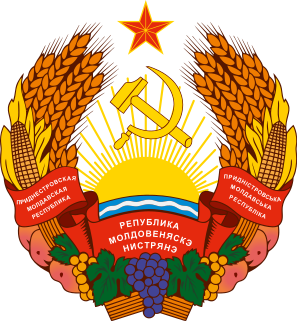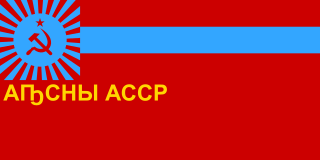
South Ossetia, officially the Republic of South Ossetia – the State of Alania, or The Tskhinvali Region, is a disputed territory in the South Caucasus, in the northern part of the internationally recognised Georgian territory. It has a population of 53,000 people who live in an area of 3,900 km2, south of the Russian Caucasus, with 30,000 living in Tskhinvali. The separatist polity, Republic of South Ossetia, is recognised as a state by Russia, Venezuela, Nicaragua, Nauru, and Syria. While Georgia lacks control over South Ossetia, the Georgian government and most members of the United Nations consider the territory part of Georgia, whose constitution designates the area as "the former autonomous district of South Ossetia", in reference to the former Soviet autonomous oblast disbanded in 1990.

The Transcaucasian Socialist Federative Soviet Republic, also known as the Transcaucasian Soviet Federative Socialist Republic, was a constituent republic of the Soviet Union that existed from 1922 to 1936. It embraced Armenia, Azerbaijan and Georgia. As they were separated from Russia by the Caucasus Mountains, they were known traditionally as the Transcaucasian Republics. Created ostensibly to consolidate the economic situation of the region, the TSFSR was also useful in consolidating Bolshevik control over the states. It was one of the four republics to sign the treaty establishing the Soviet Union in 1922.

The President of Georgia is the constitutional Head of State of Georgia as well as the Supreme Commander-in-Chief of the Defense Forces. They represent Georgia in foreign relations. The constitution defines the presidential office as "the guarantor of the country’s unity and national independence."

This is a list of referendums related to the European Union, or referendums related to the European Communities, which were predecessors of the European Union. Since 1972, a total of 48 referendums have been held by EU member states, candidate states, and their territories, with several additional referendums held in countries outside of the EU. The referendums have been held most commonly on the subject of whether to become a member of European Union as part of the accession process, although the EU does not require any candidate country to hold a referendum to approve membership or as part of treaty ratification. Other EU-related referendums have been held on the adoption of the euro and on participation in other EU-related policies.

The Abkhaz–Georgian conflict involves ethnic conflict between Georgians and the Abkhaz people in Abkhazia, a de facto independent, partially recognized republic. In a broader sense, one can view the Georgian–Abkhaz conflict as part of a geopolitical conflict in the Caucasus region, intensified at the end of the 20th century with the dissolution of the Soviet Union in 1991.

The Parliament of Georgia the supreme national legislature of Georgia. It is a unicameral parliament, currently consisting of 150 members; of these, 77 are proportional representatives and 73 are elected through single-member district plurality system, representing their constituencies. According to the 2017 constitutional amendments, the Parliament will transfer to fully proportional representation in 2024.

The Union of Sovereign States was the proposed name of a reorganization of the Union of Soviet Socialist Republics into a new confederation. Proposed by the then President of the Soviet Union, Mikhail Gorbachev, the proposal was an attempt to avert an end to the Soviet Union. The proposal was never implemented in the wake of the August Coup in 1991 and the dissolution of the Soviet Union ultimately occurred on December 26th of that year. The overall proposal was resurrected as the Commonwealth of Independent States (CIS), although as a regional organization, not a confederation.

This article refers to the history of Abkhazia from its pre-historic settlement by the lower-paleolithic hunter-gathers during the mesolithic and neolithic periods to the post-1992-1993 war situation.

Referendums in Transnistria, according to the Transnistrian Constitution, are one of the lawful forms of expression of people's will.
The Sukhumi riot was a riot in Sukhumi, Abkhaz Autonomous Soviet Socialist Republic, Georgian Soviet Socialist Republic, Soviet Union, in July 1989, triggered by an increasing inter-ethnic tensions between the Abkhaz and Georgian communities and followed by several days of street fighting and civil unrest in Sukhumi and throughout Abkhazia.

Georgia and North Atlantic Treaty Organization (NATO) relations officially began in 1994 when Georgia joined the NATO-run Partnership for Peace. Georgia has moved quickly following the Rose Revolution in 2003 to seek closer ties and eventual membership with NATO. Georgia's powerful northern neighbor, Russia, has opposed the closer ties, including those expressed at the 2008 Bucharest summit where NATO members promised that Georgia would eventually join the organization. In the 7 December 2011 statement of the North Atlantic Council Georgia was designated as an "aspirant country".
A constitutional referendum was held in Abkhazia on 3 October 1999, alongside presidential elections. Voters were asked whether they approved of the constitution that had been approved by the Supreme Soviet on 26 November 1994, together with an amendment abolishing the life term for appointed judges and replacing it with five year terms. It was approved by 97.7% of voters. However, ethnic Georgians who had been expelled from Abkhazia during the conflict of 1992–93 did not participate in the referendum and the results were not recognised internationally.

An independence referendum was held in the Republic of Georgia on 31 March 1991. It was approved by 99.5% of voters.
Parliamentary elections were held in Abkhazia on 23 November 1996, with a second round on 7 December. There was also a simultaneous referendum held amongst Abkhazian refugees.

This article describes the background of the Russo-Georgian War.

A referendum on the future of the Soviet Union was held on 17 March 1991. The question put to voters was
The National Forum Aidgylara is a socio-political movement in Abkhazia. It was founded during Perestroika as the ethno-nationalist movement representing the Abkhaz people. Aidgylara's founding congress took place on 13 December 1988 in the building of the Abkhazian State Philharmonic Orchestra, where the writer Alexey Gogua was elected its first Chairman.
A referendum on sovereignty was held in the Crimean Oblast of the Ukrainian SSR on 20 January 1991 two months before the 1991 All-Union referendum. Voters were asked whether they wanted to re-establish the Crimean Autonomous Soviet Socialist Republic, which had been abolished in 1945. The proposal was approved by 94% of voters.

The Ukrainian sovereignty referendum was conducted on March 17, 1991, as part of the first and only Soviet Union referendum. Throughout the Ukrainian Soviet Socialist Republic, voters were asked two questions, with an additional question attached to the ballot in the historical region of Galicia which includes the Ukrainian provinces of Ivano-Frankivsk, Lviv, and Ternopil.
















